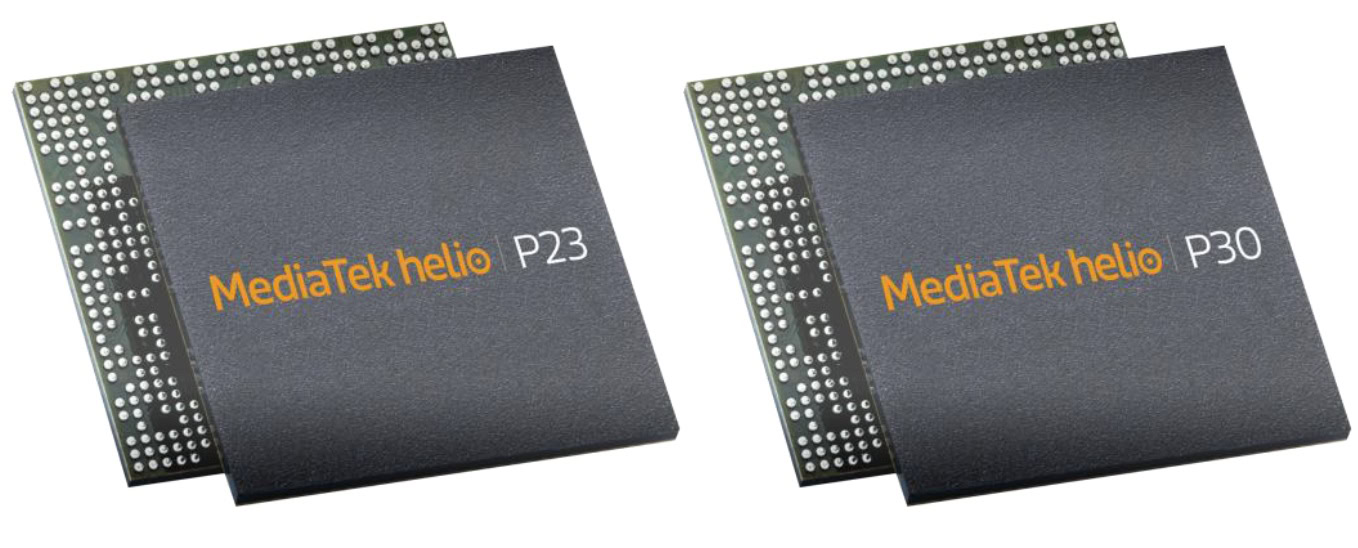Affiliate links on Android Authority may earn us a commission. Learn more.
MediaTek Helio P30 and P23 arrive with improved multimedia

Today, chip designer MediaTek has unveiled two new products for its mid-range Helio P series, designed to enhance the multimedia experience of handsets sold at an affordable price point. The new Helio P30 is the higher end option, bridging the gap with the higher-end Helio X range, while the P23 is more of a successor to last year’s P20.
Leaping right on into the performance side of the announcement, the 16nm octa-core CPU arrangement will feel very familiar to MediaTek users. Both the P30 and P23 features eight Cortex-A53 cores arranged in two clusters of four. Frequencies tap out at 2.3 GHz, meaning that CPU performance will be pretty much identical to previous models. On the memory side, there’s familiar support for up to 6GB of LPDD4X RAM running at 1600 MHz too.
MediaTek has moved over to ARM’s Bifrost based Mali-G71 GPU though, configured with two core clusters. The Helio P23’s GPU offers a 770 MHz clock speed, which ramps up to 950 MHz in the P30. We know that the G71 boasts better performance, energy efficiency, and bandwidth improvements over the T880, and MediaTek says there’s about a 20 to 25 percent performance difference between the two chips.
| Helio P30 | Helio P23 | Helio P20 | Helio X30 | |
|---|---|---|---|---|
CPU | Helio P30 4x Cortex A53 @ 2.3 GHz 4x Cortex A53 @ 1.65 GHz | Helio P23 4x Cortex A53 @ 2.3 GHz 4x Cortex A53 @ 1.65 GHz | Helio P20 4x Cortex A53 + 4x Cortex A53 @ 2.3 GHz | Helio X30 2x Cortex A73 @ 2.5 GHz 4x Cortex A53 @ 2.2 GHz 4x Cortex A53 @ 1.9 GHz |
GPU | Helio P30 Mali-G71MP2 @ 950 MHz | Helio P23 Mali-G71MP2 @ 770 MHz | Helio P20 Mali-T880MP2 @ 900 MHz | Helio X30 PowerVR GT7400 Plus @ 800 MHz |
Memory | Helio P30 32-bit dual channel @1600 MHz LPDDR4X | Helio P23 32-bit dual channel @1600 MHz LPDDR4X | Helio P20 32-bit dual channel @1600 MHz LPDDR4X | Helio X30 16-bit quad-channel @ 1866 MHz LPDDR4X |
Cameras | Helio P30 16 + 16 megapixel (with CCU + VPU) | Helio P23 13 + 13 megapixel (with CCU) | Helio P20 13 + 13 megapixel | Helio X30 16 + 16 megapixel (with CCU + VPU) |
Process | Helio P30 16mn FinFET | Helio P23 16mn FinFET | Helio P20 16nm FinFET | Helio X30 10nm FinFET+ |
What’s a little more interesting is that MediaTek’s Camera Control Unit (CCU) from its top of the line Helio X processors makes its way into these new chips. The CCU is designed specifically to speed up focal and exposure correction, ensuring good looking images even in fast moving scenes. The camera processing pipeline is further improved in the Helio P30, with the introduction of a dedicated Vision Processing Unit (VPU) clocked at 500 MHz.
This VPU is a Tensilica DSP designed specifically for running data intensive calculation inside an efficiency power budget. This technology is often associated with audio and voice processing, but it’s also highly applicable for image processing in a dual camera environment. MediaTek is making the VPU APIs available for developers to use, and the unit can also be built into heterogeneous compute applications, which is an approach we’ve seen Qualcomm take with its processor components too. A number of third parties have committed to support the VPU platform already, including Almalence, ArcSoft, Core Photonics, OT-Morpho, Sensory, and Itseez.
Before we finish talking about cameras, the Helio P25 supports 13 + 13 megapixel dual camera configurations, or a single 24 megapixel sensor. The P30 model supports dual 16 megapixel cameras or a single 25 megapixel sensor. Supported dual camera configuration includes RGB + monochrome, wide angle, and telephoto lenses.
Rounding off the multimedia aspect of the chips, both SoCs also boast a dedicated multimedia processing unit with decode support for H.265 (HEVC) 4K2K video at 30fps. There’s no support for ultra high resolution displays in these mid-range chips though, but both the P23 and P30 support up to 2160 x 1080 (FHD+) display panels.
With improved dual camera support, worldwide dual SIM LTE, and a more efficient GPU, MediaTek's latest Helio P products are pushing mid-range feature sets forward. Even though we aren't looking at any major performance boosts this time around.
The other major point of interest with these new Helio P30 and P25 products is their dual 4G SIM functionality. Between them, these two offer the world’s first dual SIM, dual 4G VoLTE/ViLTE support. What that means is that both SIM slots not only support 4G data, but also voice and video LTE calling options for each SIM card. Furthermore, there’s MediaTek’s TAS 2.0 smart antenna technology, which can adjust the antenna configuration for optimal signal regardless of how the phone is being held. The technology only requires one antenna, but can switch between two states with opposite radiation directions to ensure that minimal signal is blocked the user’s hands.
MediaTek sees the P25 as a global product and as such MediaTek has ensured support for worldwide LTE networks in its latest releases. The WorldMode chipset supports 4G LTE-Advanced (FDD-LTE and TDD-LTE), and legacy 3G/2G technologies such as WCDMA, TD-SCDMA, CDMA2000/EVDO, EDGE and GSM. There’s also HPUE support for TDD spectrum carriers like Sprint, and high frequency 600 MHz band support for the likes of T-Mobile, if these products were to appear in the US.
Both the Helio P30 and Helio P25 will be available globally in Q4 2017. Being a higher-end product, the P30 is more likely to appear in China and a selection of other Asian markets first.